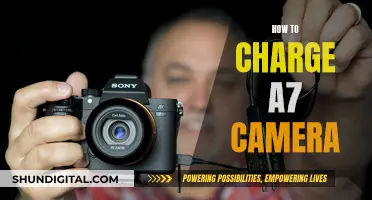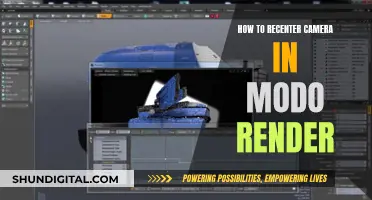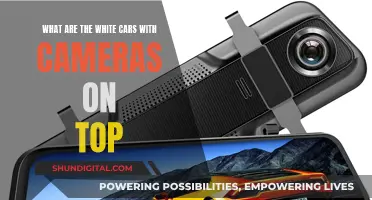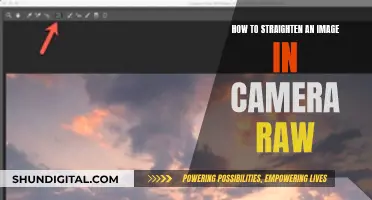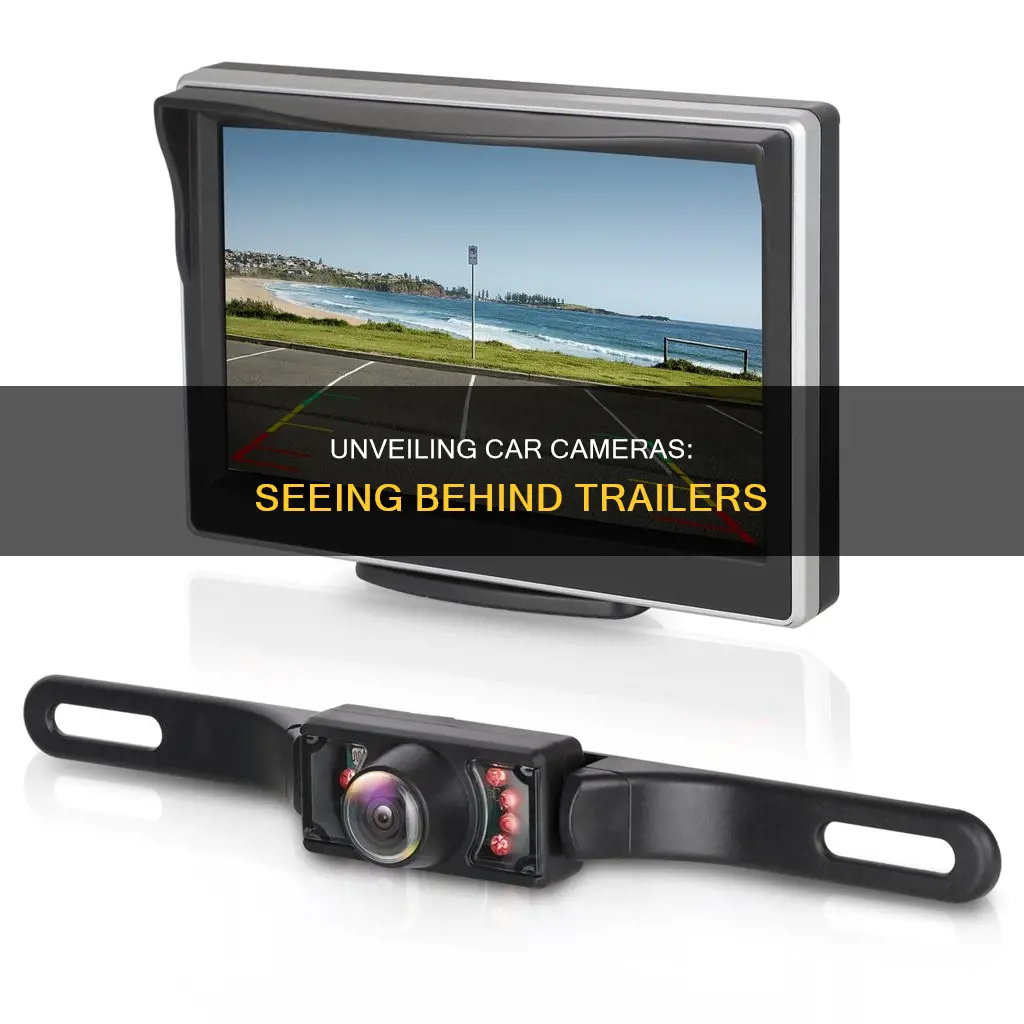
The latest in truck technology is the see-through trailer camera, which allows drivers to see what's behind their trailers. This camera system is designed to improve safety, especially for trucks towing large loads that could become unhitched or hit something the driver didn't notice. The see-through effect is achieved by lining up images from cameras attached to the back of the trailer and the truck, detecting the edges of the trailer, and presenting a transparent image on the centre touchscreen. This innovative technology enhances driver awareness and reduces blind spots, making it easier and safer to navigate and park large vehicles.
| Characteristics | Values |
|---|---|
| Camera Type | Backup Camera, Rearview Camera, Multi-Camera System |
| Functionality | Sees through trailers, 360-degree view, bird's-eye view, transparent view |
| Camera Angles | Front, rear, side, hitch, bed, wide-angle rear surround, bowl |
| Camera Features | Manual and automatic switching, image stitching, edge detection and outlining |
| Display | Center touchscreen, digital dashboard, iPad |
| Camera Mounting | Back of the trailer, back of the truck, vehicle's bumper, dashboard, sun visor |
| Camera Connectivity | Wired, wireless |
| Camera Models | ProGrade Trailering Camera System, Voyager, EsiCam, Furrion FOS48TAPK-BL |
| Vehicle Models | Chevrolet Silverado 1500/2500 HD, GMC Sierra 1500/2500/3500, Ram, Toyota 4-Runner |
What You'll Learn

Camera placement
The ProGrade Trailering Camera System, offered by certain truck manufacturers, is a prime example of effective camera placement. This system utilises multiple cameras positioned at different locations on the truck and trailer to provide a comprehensive view of the surroundings.
Firstly, there are three front-facing camera angles on the truck itself, allowing the driver to see what is directly in front of them. Additionally, four rear camera angles are included, providing a clear view of the rear of the truck and helping to eliminate blind spots.
For the trailer, a camera is typically placed at the back, facing rearward. This camera works in conjunction with the rear camera on the truck to create a "see-through" effect, making the trailer appear invisible and allowing the driver to see vehicles directly behind the trailer. This is achieved by lining up the images from both cameras and detecting the edges of the trailer, which are then outlined on the display.
In addition to the rear-facing trailer camera, some systems may also include cameras for the hitch and bed, allowing the driver to monitor the cargo box and ensure everything is secure.
Another important aspect of camera placement is the positioning of the display monitor. In many cases, the monitor is integrated into the centre touchscreen of the vehicle, providing a clear and easily accessible view of the camera feeds.
Furthermore, some camera systems may include side-view or mirror-mounted cameras, providing additional visibility of the lanes beside the vehicle and reducing the need for physical side mirrors.
Overall, the placement of cameras in these "see-through" trailer camera systems is carefully designed to provide maximum visibility and improve the safety of the driver and those around them.
Best Cameras for RAW Photography Enthusiasts
You may want to see also

Image stitching
The process typically involves the use of multiple cameras strategically positioned to capture front, rear, and side exterior angles. These cameras capture images or video streams that are then processed and stitched together to create a seamless panoramic view.
In the case of trailer cameras, there is usually a camera attached to the back of the trailer and another camera on the back of the truck. The images from these two cameras are aligned and stitched together, creating a transparent or "see-through" effect, where the trailer appears invisible. This allows the driver to see any vehicles or obstacles directly behind the trailer, enhancing safety and manoeuvrability.
The image stitching process involves advanced image processing techniques to ensure a smooth and accurate composite image. It includes techniques such as edge detection to outline the trailer box, image registration to align the images correctly, and intensity blending to remove any brightness differences at the tile borders.
Additionally, the system may utilise different camera angles and views to assist the driver further. This includes camera angles for the hitch, bed, rear surround, and even inside the trailer. These multiple views provide a comprehensive understanding of the vehicle's surroundings, improving overall safety during towing operations.
Smart Strategies for Carrying Extra Camera Batteries
You may want to see also

Displaying the stitched image
In the context of "see-through" trailer cameras, the stitched image is created by lining up the images from the camera attached to the back of the trailer and the rear camera on the truck. This process involves detecting the edges of the trailer box and outlining it. The resulting stitched image is then displayed on the center touchscreen, providing a transparent view of the trailer and any vehicles directly behind it.
The process of displaying the stitched image can be broken down into the following steps:
- Image Capture: The first step is to capture images from multiple cameras positioned around the vehicle. These cameras are strategically placed to capture the necessary exterior angles.
- Image Stitching: The captured images are then stitched together using image processing techniques. This involves detecting keypoints and extracting local invariant descriptors from the images, followed by applying keypoint matching to construct a homography matrix.
- Homography Matrix Application: The homography matrix is then used to transform and warp the images, creating the final stitched image.
- Display: The stitched image is then displayed on a center touchscreen or dashboard display, providing the driver with a transparent view of the trailer and any obstacles behind it.
It is important to note that the process of image stitching and homography matrix estimation is computationally expensive. To optimize performance, it is assumed that the cameras are fixed and non-moving. By caching the homography matrix, subsequent image stitching can be performed more efficiently, enabling real-time updates of the stitched image.
Overall, the process of displaying the stitched image involves capturing images from multiple cameras, stitching them together using image processing techniques, and then presenting the final stitched image on a display to provide the driver with an enhanced view of their surroundings.
Adjusting Your Vivotek Camera: Tips for Optimal Focus
You may want to see also

Camera interference
One of the main issues with wireless camera systems is interference from other wireless components. Wireless cameras transmit signals through airways, and if there are multiple wireless devices in close proximity, the signals can interfere with each other. This interference can result in poor reception and disrupted images, compromising the effectiveness of the camera system.
The positioning of the camera is also crucial to minimizing interference. In some cases, the camera's position may be less than optimal, leading to signal disruption. For example, if the camera is mounted inside the vehicle on the dashboard or sun visor, the signal may be blocked or weakened by the vehicle's structure. This can result in a lower-quality image or even a complete loss of signal.
Additionally, external factors such as weather conditions and physical obstructions can interfere with wireless camera signals. Inclement weather, such as heavy rain or snow, can disrupt the transmission of signals, affecting the reliability of the camera system. Similarly, physical obstacles, such as tall buildings or dense foliage, can block or distort signals, impacting the overall performance of the camera.
To mitigate these issues, some drivers opt for wired camera systems, which are generally considered to provide better quality and more reliable connections than wireless setups. Wired cameras use physical cables to transmit signals between the camera and the display monitor, reducing the chances of interference and signal disruption. However, wired systems may be less convenient to install and may require more extensive modifications to the vehicle.
In conclusion, while new car cameras that see behind trailers offer valuable visibility enhancements, they are susceptible to interference, particularly in the case of wireless setups. To ensure optimal performance and minimize interference, careful consideration must be given to camera placement, the surrounding environment, and the potential benefits of wired versus wireless systems.
The Fastest Autofocus Cameras: Instant Focus, Instant Capture
You may want to see also

Wired vs wireless cameras
When it comes to wired vs wireless cameras, there are several factors to consider, including price, quality, and convenience.
Wired Cameras
Wired cameras are known for their reliability and high picture quality. They offer a direct connection between the camera and the monitor, resulting in a crisp and clear picture with minimal interference. The wiring can handle more data and provides a faster image transfer, ensuring a sharp and focused view. With a wired camera, you don't have to worry about signal strength or interference, and you can always expect a clear signal and uninterrupted video, no matter the weather conditions.
However, the installation process for wired cameras can be tricky and time-consuming. You may need to hire a professional, especially for longer vehicles like RVs, which can double or triple the overall cost. Wired cameras are also generally more expensive than wireless ones due to the higher quality and installation costs.
Wireless Cameras
Wireless cameras, on the other hand, are much easier to install and are often preferred for longer vehicles. They don't require any wiring and can be set up in just a few minutes. Wireless cameras are also usually cheaper than wired ones since they require less equipment. Additionally, some wireless cameras can be integrated into navigation systems, making them more technologically advanced.
However, one of the main drawbacks of wireless cameras is the occasional lapse in signal strength and picture quality. Wireless cameras, especially those using an analog signal, are prone to static and signal drops, resulting in a poor or fuzzy picture. While digital signals are more reliable, they can still experience interference from time to time. Wireless cameras may not be the best option for those who want 100% reliability.
In summary, if you're looking for a proven, reliable, and permanent solution, a wired camera system is a good choice. However, if you're on a tighter budget or prefer a quicker and easier installation, a wireless camera might be a better option.
Low Battery, Low Quality: Camera Performance Impact
You may want to see also
Frequently asked questions
New car cameras can see behind trailers using a "see-through" system. This system uses a multi-camera setup with 15 different camera angles to improve the driver's visibility. It works by lining up the images from the camera attached to the back of the trailer and the camera on the back of the truck, detecting the edges of the trailer box, and outlining it. This allows the driver to see any vehicles that are directly behind the trailer.
Car camera systems offer several benefits, including improved safety, convenience, and vehicle security. They can help eliminate blind spots, make parking easier, and provide a clear view of the vehicle's surroundings. Additionally, they can be used to monitor the driver's awareness and behaviour to combat drunk driving or distraction.
A typical surround-view camera system uses four cameras positioned at the front, rear, and sides of the vehicle. However, some systems may use up to six cameras to provide additional views and enhance the driver's visibility.
There are several car camera systems available in the market, such as the ProGrade Trailering Camera System offered by Chevrolet and GMC for their truck models. Other popular options include the Voyager camera system, the Furrion wireless RV observation system, and the RVS InView 360° Camera System.
Wired camera systems are generally considered to provide better quality than wireless systems. Wireless systems use radio signals to transmit images, which can sometimes result in poor signal reception and interference with other wireless components. Wired systems have a direct connection between the camera and the display monitor, ensuring a consistent and reliable image quality.


